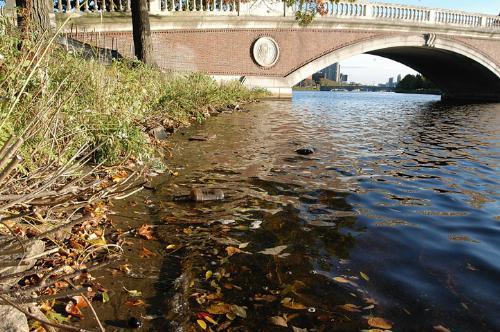
News
Summers Will Not Finish Semester of Teaching as Harvard Investigates Epstein Ties

News
Harvard College Students Report Favoring Divestment from Israel in HUA Survey

News
‘He Should Resign’: Harvard Undergrads Take Hard Line Against Summers Over Epstein Scandal

News
Harvard To Launch New Investigation Into Epstein’s Ties to Summers, Other University Affiliates

News
Harvard Students To Vote on Divestment From Israel in Inaugural HUA Election Survey
Pollution Threatens Charles

Environmentalists worry that a permit under development by the Environmental Protection Agency (EPA) may delay the agency’s goal for a swimmable and fishable Charles River by 2005.
The draft permit for the Mirant Kendall Station, located in Cambridge downstream from the Longfellow Bridge, would allow the plant to continue using the Charles to clean its turbines.
Under both the expired and draft permits, the natural gas plant can use water from the nearby Broad Canal to cool its turbines and eject millions of gallons of water into the river at 105 degrees in a process known as once-through cooling.
The new draft will allow Mirant to eject up to 70 million gallons of water a day.
The EPA estimates Mirant currently ejects 4.7 million gallons, on average, into the river daily.
Representatives from Mirant, which filed for bankruptcy in July, could not be reached for comment yesterday.
Some environmental groups are using the permit renegotiation process to criticize what they see as existing environmental abuse by the power plant.
Julia Bovey, a spokeswoman for the Conservation Law Foundation, said she was concerned that under the new permit, the plant might send “excess amounts of super-hot water” into the Charles. Historically, the plant has not taken full advantage of the capacity set forth by the permit, Bovey said.
The Conservation Law Foundation, New England environmental group, submitted a 28-page criticism of the draft permit to the EPA.
Bovey said that the draft permit “is not different from the old permit,” but its effects could be more harmful if the plant chooses to utilize its full capacity.
“The improvement in the Charles River over the last 20 years have been vast,” said Bovey. “To take a step backwards would be a shame.”
According to Bovey, the new proposal could turn half of the river from the Longfellow Bridge to the Museum of Science into a “dead zone” for indigenous fish, including the alewife and yellow perch.
The hot water could also worsen existing algae blooms as far upriver as the Mass Ave. bridge, according to EPA state manager David Webster.
But Webster claimed that industrial operations, such as the Mirant Kendall Station, only account for a fraction of the Charles’s pollution.
“There are two standards for swimmability,” he said. “One is bacteria content, which the Mirant Kendall Station doesn’t affect much.”
Sewer overflows during rain and illicit dumping of raw sewage directly into the river contribute to bacterial pollution, Webster said.
Water cloudiness is also only partially determined by industry.
“A lot of the controversy is scientific interpretation,” Webster said. “But embedded in that is how confident you want to be in numbers.”
The draft permit has sparked so much public interest that the EPA extended a public comment period to Oct. 14.
“We received voluminous comments from both sides, and we’re very happy with their thoughtfulness,” Webster said.
“This is fascinating stuff....[t]here is a lot of good scientific debate.”
The EPA will review the draft comments in the next few months and produce a final permit in 2005, Webster said.
If there are “significant changes” from the draft version, the EPA will hold another public comment period.
Webster acknowledged the challenge of crafting a permit acceptable to everyone.
“It’s a little like setting a speed limit,” he said. “50 miles per hour is always safer than 55 or 60. The problem is finding the right balance.”
Dissenting parties will be able to make legal challenges, both within the EPA and in circuit court.
If water quality were to decline, Brian C. Aldrich ’07, a member of the men’s lightweight crew, said “[The sport] wouldn’t be affected too much.”
But “the interaction with the river would be changed....[i]t’s nice to jump in on a warm day,” said Aldrich, who has rowed on the river for eight years.
Want to keep up with breaking news? Subscribe to our email newsletter.
